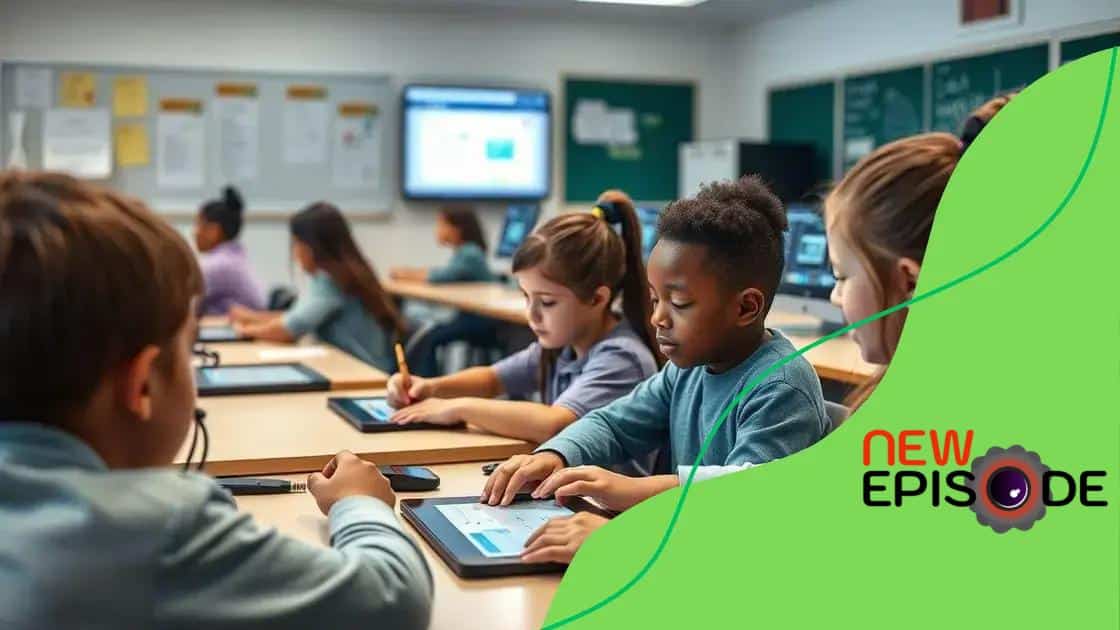How AI is transforming personalized learning tools

AI is transforming personalized learning tools by providing tailored educational experiences, enhancing engagement, and supporting educators with data-driven insights.
How AI is transforming personalized learning tools is an exciting journey into the future of education. Have you ever wondered how technology can customize learning just for you? Let’s dive into this evolving landscape.
The role of AI in personalized learning
The role of AI in personalized learning is becoming increasingly vital. As technology evolves, we find ourselves in an age where education is tailored to meet individual needs. This shift not only enhances understanding but also fosters a deeper engagement with the material.
How AI Adapts Learning
One of the main advantages of AI is its ability to analyze data and adapt learning experiences accordingly. By assessing students’ strengths and weaknesses, AI can create customized learning paths. This means that each student can learn at their own pace, making education much more effective.
Benefits of AI in Education
Implementing AI tools in classrooms offers numerous benefits:
- Individualized Learning: Each student receives a learning plan tailored just for them.
- Real-time Feedback: Students get instant feedback, which helps them improve quickly.
- Enhanced Engagement: AI can make learning more interactive and fun, keeping students interested.
Another important aspect is the use of intelligent tutoring systems. These systems provide support similar to a personal tutor, helping students when they face challenges. By utilizing algorithms, these tools can offer hints and tips, facilitating a smoother learning experience.
As we dive deeper into the possibilities of AI in education, it’s crucial to consider how it complements traditional teaching methods. Rather than replacing teachers, AI serves as a valuable assistant, enabling educators to focus more on fostering relationships with their students. This collaboration is key to improving educational outcomes.
Overall, the role of AI in personalized learning is transformative. As we harness its power, we can create learning environments that are not only more effective but also more enjoyable for learners of all ages.
Advantages of AI-driven education
The advantages of AI-driven education are numerous and significant. With the integration of artificial intelligence in learning environments, students can benefit in many ways. Enhanced learning experiences and improved academic performance are just a couple of the outcomes.
Personalized Learning Experiences
One major benefit is that AI enables truly personalized learning experiences. AI algorithms analyze student performance and adapt the curriculum to fit individual needs. As a result, learners can progress at their own pace and focus on areas that require improvement.
Efficient Learning Processes
AI also streamlines the learning process. By automating routine tasks such as grading and assessment, it frees up valuable time for teachers. This allows educators to dedicate more attention to engaging with students and providing tailored support.
- Instant Feedback: Students receive immediate responses to their questions, helping them learn more effectively.
- Data-Driven Insights: Educators can leverage insights from data collected by AI to enhance their teaching strategies.
- Adaptive Learning Paths: AI creates unique learning journeys based on individual progress.
Moreover, AI-driven education is accessible to a wider audience. Students from various backgrounds can engage with high-quality educational resources. This democratization of learning helps bridge gaps in educational equity.
In addition to these benefits, the interactive nature of AI tools keeps students motivated. By offering gamified elements or virtual simulations, learners find the educational process more enjoyable and engaging. This, in turn, leads to better retention and understanding of concepts, making education not only effective but fun.
Overall, the advantages of AI-driven education highlight the transformative potential of technology in the classroom. As we continue to embrace these advancements, the future of learning looks brighter and more inclusive than ever.
Challenges in implementing AI tools

The challenges in implementing AI tools in education can seem daunting, yet they are crucial to understand for successful integration. As schools and institutions adopt these technologies, they face various obstacles that can impact effectiveness.
Technical Issues
One common challenge is the technical complexity of AI systems. Educators and administrators often require training to fully utilize these tools. Without proper knowledge, potential benefits may not be realized.
Cost Considerations
Another significant hurdle is the cost associated with deploying AI technologies. Many schools struggle with limited budgets, making it difficult to invest in new tools and infrastructure.
- Maintenance Costs: Ongoing support and updates can strain finances.
- Initial Setup: Implementing AI often requires substantial initial investment.
- Training Expenses: Training staff to effectively use AI tools can add to costs.
In addition to budget concerns, schools must also consider data privacy and security. AI tools rely on student data to function effectively. Protecting this information is essential, and schools need robust systems in place to ensure compliance with regulations.
The resistance to change can further complicate the implementation process. Some educators may be hesitant to adopt new technologies, preferring traditional methods. It is vital to address these concerns through professional development and open discussions about the benefits of AI.
Moreover, the effectiveness of AI tools can vary based on the context in which they are used. Not every tool is suitable for every learning environment, which can lead to misalignment between technology and educational goals. Therefore, careful consideration and planning are necessary for successful integration.
Ultimately, while the challenges of implementing AI tools in education are significant, they can be addressed through strategic planning and commitment from all stakeholders involved.
Real-world examples of AI in classrooms
Real-world examples of AI in classrooms showcase the transformative power of technology in education. Many schools around the world are already harnessing the potential of AI to improve teaching and learning experiences.
Intelligent Tutoring Systems
One prominent example is the use of intelligent tutoring systems. These systems analyze individual student data and provide personalized learning experiences. For instance, platforms like Knewton adapt lessons based on student performance, ensuring that learners receive assistance in areas where they struggle.
AI-Powered Assessment Tools
Another example is AI-powered assessment tools. Gradescope allows educators to grade assignments efficiently by using AI to assist with the assessment process. This not only saves time but also ensures consistency in grading.
- Automated Feedback: Students receive immediate feedback, helping them address misconceptions quickly.
- Streamlined Grading: Teachers can focus on instructional time rather than paperwork.
- Data Analytics: Educators gain insights into student performance trends.
Moreover, AI chatbots like IBM Watson have been implemented in some educational institutions. These chatbots assist students by answering queries and providing instant support. This availability enhances student experience and helps them access resources at any time.
Additionally, AI is being used in virtual learning environments to create engaging educational content. Tools such as Quillionz generate quizzes and study material based on the material taught in class, making it easier for students to study and review.
The integration of AI in classrooms fosters collaboration among students through tools like Google Classroom, which simplifies project management and communication. These platforms help students work together on projects seamlessly and access resources effectively.
By examining these real-world examples, we can see that the future of education is being actively shaped by AI. Schools that embrace these technologies are likely to see improved outcomes and more engaged learners.
Future trends in educational technology
Future trends in educational technology promise exciting changes that will shape how students learn and teachers instruct. With the rapid advancement of technology, we can expect innovative tools that enhance learning experiences.
Increased Use of Artificial Intelligence
One major trend is the increased use of artificial intelligence in classrooms. As AI technology evolves, it will likely become more integrated into everyday learning. This will allow for greater personalization of educational content, where systems adapt to each student’s learning style and pace.
Virtual and Augmented Reality
Another significant trend is the rise of virtual and augmented reality in education. These technologies provide immersive experiences that can transform lessons. For instance, students can explore ancient civilizations or conduct virtual science experiments right from their classrooms.
- Interactive Learning: Virtual environments allow for more engaging lessons.
- Experiential Learning: Students can interact directly with the subject matter.
- Accessible Field Trips: Students can visit places worldwide without leaving their classrooms.
Additionally, there will be a growing focus on data analytics in education. By analyzing student performance data, educators can gain insights that enable them to make informed decisions. This data-driven approach will enhance teaching strategies and optimize learning outcomes.
Furthermore, we can expect the rise of online and blended learning models. These models offer flexibility, allowing students to learn at their pace and convenience. As technology continues to improve, access to quality education will become more equitable for all students.
Collaborative learning tools are also expected to advance, allowing students to work together seamlessly, whether in the same room or across the globe. Platforms that promote communication and collaboration will enable learners to develop essential teamwork and problem-solving skills.
Overall, the future of educational technology is bright, with countless opportunities to enhance learning experiences. By embracing these trends, educators can better prepare students for the challenges of tomorrow.
In conclusion, the integration of AI in education presents numerous opportunities for enhancing the learning experience. With personalized learning paths, innovative tools, and interactive environments, students can engage more deeply with the content. While challenges exist, such as technical issues and costs, the benefits of AI-driven education far outweigh these concerns. By embracing future trends such as AI, virtual reality, and data analytics, educators can prepare students for a brighter future. Together, we can transform how education is approached, ensuring that every learner reaches their full potential.
FAQ – Frequently Asked Questions about AI in Education
How is AI transforming personalized learning in classrooms?
AI personalizes education by adapting learning experiences to each student’s needs, allowing them to progress at their own pace.
What are some real-world applications of AI in education?
Real-world applications include intelligent tutoring systems, AI-powered assessment tools, and virtual reality experiences.
What challenges do schools face when implementing AI tools?
Challenges include technical complexities, costs, data privacy concerns, and resistance to change from educators.
How can teachers benefit from AI in their teaching?
Teachers benefit from AI through time-saving tools, enhanced student engagement, and data insights that inform teaching strategies.






